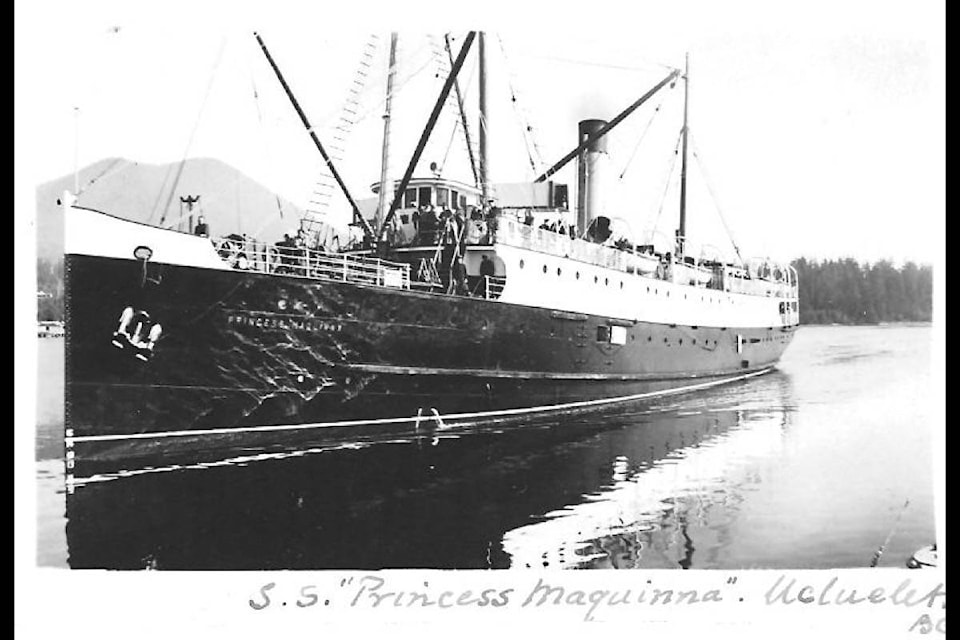SHIRLEY MARTIN
Special to the Westerly
The ships servicing the west coast were a lifeline to the small communities and outposts.
A link to the outside world, they carried mail, supplies and passengers. Steamship arrivals were eagerly anticipated. Schedules had to be flexible, as weather conditions, tides and extra stops all affected arrival times.
The Maude was the first ship on the regular west coast steamship run, starting in 1897. She was followed by the Willipa and the Queen City.
In 1901 the Canadian Pacific Railway bought all the steamers owned by the B.C. Coastal Steamship service. The most dangerous routes they served were along Vancouver Island’s west coast.
In 1902 the Willipa gave up her route, and was replaced by the Tees in 1903. Sometimes referred to as a wallowing tub, the Tees sat low in the water in rough seas. Many a sailor succumbed to sea sickness aboard the Tees, a.k.a. the “Holy Roller”.
The west coast route needed a bigger and better ship. The Princess Maquinna, built in Victoria, was quite a contrast to the wallowing Tees. 244 feet long and weighing 1777 tons, she was the largest steel vessel built in B.C. up to that time. She was fittingly named for a princess, daughter of Chief Maquinna, powerful ruler of the Nootka. The Princess Maquinna left Victoria on her maiden voyage on July 20, 1913. Cheering crowds welcomed the new ship at each stop along the coast.
Captain Edward Gillam, former skipper of the Tees, commanded the Maquinna for her first 16 years. He was a master at using the piercing whistle to navigate in fog, gauging location by the whistle’s echo. His finely tuned ear was also noted in his musical ability. At gatherings in small outposts, Capt. Gillam played dance music with his violin. He also played a convincing Santa Claus at Christmas.
The Maquinna earned the monikers “the Good Ship Maquinna”, ‘Old Faithful’ and ‘Old Reliable’. Her skippers and crewmen were reliable as well. Certified deep-sea sailors, they ably dealt with wild weather, heavy seas and a treacherous coastline.
In 1929 a new steamer, the Princess Norah, was brought over from Scotland to supplement coastal access. Her main task was to transport tourists on west coast excursions.
Captain Gillam skippered the new ship for just three weeks before passing away from a head injury at the age of 65. He had fallen off a ladder aboard the Princess Norah in heavy seas off Tofino.
His presence was sadly missed all along the coast.
By 1952 big changes were happening on the west coast. Large packers were transporting fish. Some communities (although not yet Ucluelet), were accessed by roads, enabling freight truck transport. Many passengers chose travel by plane rather than ship. Operating the Maquinna went from the black into the red. She needed repairs, and it was not financially viable.
When the Maquinna left Victoria on Sept. 4th, 1952 her boilers gave out and she limped to a nearby dock. “Old Reliable” had finally worn out. In 1953 she was stripped down, converted to an ore carrier, and renamed the Taku. In 1962 she was towed to False Creek and cut up for metal. The Good Ship Maquinna was no more, but she left cherished memories of a beloved west coast legend. The binnacle from the Maquinna was given to the Ucluelet Sea Cadets and is now under the care of the Ucluelet and Area Historical Society. It is on display at the District Office, until our dream of a Ucluelet museum becomes a reality.
Shirley Martin is a member of the Ucluelet and Area Historical Society. The longtime Ucluelet resident is the author of two children’s picture books: ‘A is for Amphitrite’ and ‘Through Grandma & Grandda’s Binoculars’.
